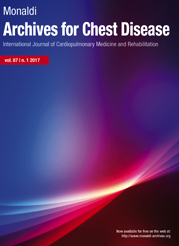A study to assess the utility of forced expiratory volume in 1 second/forced expiratory volume in 6 seconds in diagnosing obstructive airway disease
All claims expressed in this article are solely those of the authors and do not necessarily represent those of their affiliated organizations, or those of the publisher, the editors and the reviewers. Any product that may be evaluated in this article or claim that may be made by its manufacturer is not guaranteed or endorsed by the publisher.
Authors
According to the Global Initiative for Chronic Obstructive Lung Disease criteria, the ratio of forced expiratory volume in the 1st second (FEV1) and forced vital capacity (FVC) is required to diagnose chronic obstructive pulmonary disease. However, it becomes difficult for all patients to meet the proper criteria. Hence, replacing FVC with forced expiratory volume after 6 seconds (FEV6) can help patients get results early with fewer complications. This study was done to assess whether the FEV1/FVC can be replaced with FEV1/FEV6. A year-long observational cross-sectional study was conducted from January 2022 to January 2023. A total of 227 patients were enrolled from the respiratory medicine department. Demographic details and data from spirometry were recorded. Receiver operating characteristic (ROC) curves were created using the data analysis results. The diagnostic utility of FEV1/FVC and FEV1/FEV6 in the diagnosis of obstructive airway disease was examined. Results obtained in the study showed the average FEV6 was 2.05 with a 0.71 standard deviation. An r² value of 0.967 (p<0.05) indicated a substantial association between the FEV1/FEV6 and FEV1/FVC ratios. An ROC curve was used to show that FEV1/FEV6 could diagnose FEV1/FVC<70%; the area under the curve was 0.987 (95% confidence interval: 0.971-1.000). It has been found that 0.705 is the ideal cut-off value, resulting in 100% sensitivity and 98.2% specificity. To conclude the study, there was a substantial association between FEV1/FVC and FEV1/FEV6 in the diagnosis of obstructive airway illness. Using FEV1/FEV6, an ROC curve was created, and an ideal cut-off of 0.705 was shown to detect obstructive airway disease. Numerous lives can be saved, and prognoses can be improved by using the FEV1/FEV6 study to identify obstructive airway illnesses more easily, improve compliance, and manage them early.
Ethics approval
The study protocol was reviewed and approved by the Institutional Ethics Committee, Himalayan Institute of Medical Sciences, Swami Rama Himalayan University, Dehradun vide no SRHU/Reg/Int/2023-287(22).How to Cite

This work is licensed under a Creative Commons Attribution-NonCommercial 4.0 International License.






